EasyDCIM Dedicated Servers For WHMCS
(→Client Area) |
|||
| Line 1: | Line 1: | ||
| − | |||
| − | |||
<meta name="keywords" content="easydcim dedicated servers for whmcs, easydcim dedicated servers configuration, whmcs easydcim dedicated servers management, whmcs easydcim dedicated servers installation, whmcs easydcim dedicated servers common problems, about whmcs easydcim dedicated servers, whmcs easydcim dedicated servers documentation, whmcs easydcim dedicated servers faq, whmcs easydcim dedicated servers help, whmcs easydcim dedicated servers guide, whmcs easydcim dedicated servers wiki, whmcs easydcim dedicated servers tutorial, whmcs easydcim dedicated servers tips, whmcs easydcim dedicated servers wiki"></meta> | <meta name="keywords" content="easydcim dedicated servers for whmcs, easydcim dedicated servers configuration, whmcs easydcim dedicated servers management, whmcs easydcim dedicated servers installation, whmcs easydcim dedicated servers common problems, about whmcs easydcim dedicated servers, whmcs easydcim dedicated servers documentation, whmcs easydcim dedicated servers faq, whmcs easydcim dedicated servers help, whmcs easydcim dedicated servers guide, whmcs easydcim dedicated servers wiki, whmcs easydcim dedicated servers tutorial, whmcs easydcim dedicated servers tips, whmcs easydcim dedicated servers wiki"></meta> | ||
<meta name="description" content="ModulesGarden Wiki Contains All The Information You Need About The EasyDCIM Dedicated Servers For WHMCS Module."></meta> | <meta name="description" content="ModulesGarden Wiki Contains All The Information You Need About The EasyDCIM Dedicated Servers For WHMCS Module."></meta> | ||
| Line 6: | Line 4: | ||
=About [https://www.modulesgarden.com/products/whmcs/easydcim-dedicated-servers EasyDCIM Dedicated Servers For WHMCS]= | =About [https://www.modulesgarden.com/products/whmcs/easydcim-dedicated-servers EasyDCIM Dedicated Servers For WHMCS]= | ||
{| | {| | ||
| − | |style="padding: 10px 0px 10px 0px;"|'''EasyDCIM Dedicated Servers For WHMCS''' will allow you to move provisioning and management of EasyDCIM servers directly to your WHMCS.<br/> | + | |style="padding: 10px 0px 10px 0px;"|'''EasyDCIM Dedicated Servers For WHMCS''' will allow you to move the provisioning and management of EasyDCIM servers directly to your WHMCS.<br/> |
| − | + | The module will let you handle all crucial aspects of created servers, including their status and the SSH password.<br/> | |
| + | Concurrently, your customers will be able to overview their servers, access KVM console, manage rDNS records and more, all without leaving your website. | ||
|} | |} | ||
<!-- fixed --> | <!-- fixed --> | ||
| Line 45: | Line 44: | ||
|} | |} | ||
{| | {| | ||
| − | |style="padding: 0px 0px 0px 30px;"|✔ Toggle Automatic Order | + | |style="padding: 0px 0px 0px 30px;"|✔ Toggle Automatic Order Acceptance And Server Matching |
|} | |} | ||
{| | {| | ||
| Line 69: | Line 68: | ||
|} | |} | ||
{| | {| | ||
| − | |style="padding: 0px 0px 0px 30px;"|✔ Control Service | + | |style="padding: 0px 0px 0px 30px;"|✔ Choose OS Templates Available For Rebuilding |
| + | |} | ||
| + | {| | ||
| + | |style="padding: 0px 0px 0px 30px;"|✔ Choose OS Templates Available For Rebuilding | ||
| + | |} | ||
| + | {| | ||
| + | |style="padding: 0px 0px 0px 30px;"|✔ Control Service Actions And Email Notifications | ||
| + | |} | ||
| + | {| | ||
| + | |style="padding: 0px 0px 0px 30px;"|✔ Determine Monthly Interval Of Bandwidth Usage | ||
| + | |} | ||
| + | {| | ||
| + | |style="padding: 0px 0px 0px 30px;"|✔ Define Percentile Billing Of Bandwidth Overage | ||
|} | |} | ||
{| | {| | ||
| Line 87: | Line 98: | ||
{| | {| | ||
|style="padding: 10px 0px 0px 30px;"|✔ Boot/Reboot/Shutdown Server | |style="padding: 10px 0px 0px 30px;"|✔ Boot/Reboot/Shutdown Server | ||
| + | |} | ||
| + | {| | ||
| + | |style="padding: 0px 0px 0px 30px;"|✔ Receive Email Notification On Complete Server Creation | ||
| + | |} | ||
| + | {| | ||
| + | |style="padding: 0px 0px 0px 30px;"|✔ Change Server Hostname | ||
|} | |} | ||
{| | {| | ||
| Line 95: | Line 112: | ||
|} | |} | ||
{| | {| | ||
| − | |style="padding: 0px 0px 0px 30px;"|✔ | + | |style="padding: 0px 0px 0px 30px;"|✔ Access KVM Console (Dell And SuperMicro Servers) |
| + | |} | ||
| + | {| | ||
| + | |style="padding: 0px 0px 0px 30px;"|✔ Rebuild Server OS Using OS Templates And Your Own Credentials | ||
|} | |} | ||
{| | {| | ||
| Line 107: | Line 127: | ||
|} | |} | ||
| − | *''' | + | *'''Configurable Options:''' |
{| | {| | ||
| − | |style="padding: 10px 0px 0px 30px;"|✔ | + | |style="padding: 10px 0px 0px 30px;"|✔ Server Model |
|} | |} | ||
{| | {| | ||
| − | |style="padding: 0px 0px 0px 30px;"|✔ | + | |style="padding: 0px 0px 0px 30px;"|✔ Server Location |
|} | |} | ||
{| | {| | ||
| − | |style="padding: 0px 0px 0px 30px;"|✔ | + | |style="padding: 0px 0px 0px 30px;"|✔ OS Template |
|} | |} | ||
{| | {| | ||
| − | |style="padding: 0px 0px 0px 30px;"|✔ | + | |style="padding: 0px 0px 0px 30px;"|✔ Bandwidth |
|} | |} | ||
{| | {| | ||
| − | |style="padding: 0px 0px | + | |style="padding: 0px 0px 0px 30px;"|✔ Additional IP Addresses |
|} | |} | ||
| − | |||
| − | |||
{| | {| | ||
| − | |style="padding: | + | |style="padding: 0px 0px 0px 30px;"|✔ HDD Size |
|} | |} | ||
{| | {| | ||
| − | |style="padding: 0px 0px 0px 30px;"|✔ | + | |style="padding: 0px 0px 0px 30px;"|✔ SSD Size |
|} | |} | ||
{| | {| | ||
| − | |style="padding: 0px 0px 0px 30px;"|✔ | + | |style="padding: 0px 0px 0px 30px;"|✔ RAM Size |
|} | |} | ||
{| | {| | ||
| − | |style="padding: 0px 0px | + | |style="padding: 0px 0px 10px 30px;"|✔ CPU Cores |
|} | |} | ||
| + | |||
| + | *'''General Info:''' | ||
{| | {| | ||
| − | |style="padding: | + | |style="padding: 10px 0px 0px 30px;"|✔ Multi-Language Support |
|} | |} | ||
{| | {| | ||
| − | |style="padding: 0px 0px 0px 30px;"|✔ | + | |style="padding: 0px 0px 0px 30px;"|✔ Supports [https://www.easydcim.com EasyDCIM] v1.4.1 and Later |
|} | |} | ||
{| | {| | ||
| − | |style="padding: 0px 0px 0px 30px;"|✔ | + | |style="padding: 0px 0px 0px 30px;"|✔ Supports PHP 5.4 Up To PHP 7 |
|} | |} | ||
{| | {| | ||
| − | |style="padding: 0px 0px 0px 30px;"|✔ | + | |style="padding: 0px 0px 0px 30px;"|✔ Supports WHMCS Templates Five and Six |
|} | |} | ||
{| | {| | ||
| − | |style="padding: 0px 0px 30px 30px;"|✔ | + | |style="padding: 0px 0px 30px 30px;"|✔ Supports WHMCS V6 and V7 |
|} | |} | ||
| Line 166: | Line 186: | ||
|} | |} | ||
{| | {| | ||
| − | |style="padding: 0px 0px | + | |style="padding: 0px 0px 15px 15px;"|'''2. In the downloaded file you will find two packages that support different PHP versions.'''<br/>As presented on the screen below, the first one is dedicated to PHP 7, while the second one is aimed at PHP 5.4 up to PHP 5.6.<br/> |
| − | '' '''Note''': You can check current PHP version in your WHMCS. To do so proceed to ''' 'Utilities' → 'System' → 'PHP Info'.''' | + | '' '''Note''': You can check current PHP version in your WHMCS. To do so, proceed to ''' 'Utilities' → 'System' → 'PHP Info'.''' |
|} | |} | ||
{| | {| | ||
| Line 183: | Line 203: | ||
{| | {| | ||
|style="padding: 10px 0px 15px 15px;"|'''4. Now, we will show you how to configure a new product.'''<br/> | |style="padding: 10px 0px 15px 15px;"|'''4. Now, we will show you how to configure a new product.'''<br/> | ||
| − | Go to '' 'Setup' → 'Products/Services' → 'Servers' '' and press '' 'Add New Server' '' button. | + | Go to '' 'Setup' → 'Products/Services' → 'Servers' '' and press the '' 'Add New Server' '' button. |
|} | |} | ||
{| | {| | ||
| Line 189: | Line 209: | ||
|} | |} | ||
{| | {| | ||
| − | |style="padding: 0px 0px 15px 15px;"|'''5. Next, choose '' 'EasyDCIM' '' from '' 'Type' '' dropdown menu.<br/> | + | |style="padding: 0px 0px 15px 15px;"|'''5. Next, choose '' 'EasyDCIM' '' from the '' 'Type' '' dropdown menu.<br/> |
| − | Fill in your server name, IP address, username and password | + | Fill in your server name, IP address, username and password, then press '' 'Save Changes'.''<br/> |
| − | + | The password can be found in your EasyDCIM administrator user profile listed as '' 'API Key'.'' | |
|} | |} | ||
{| | {| | ||
| Line 197: | Line 217: | ||
|} | |} | ||
{| | {| | ||
| − | |style="padding: 0px 0px 15px 15px;"|'''6. After configuring your server, you can check connection.'''<br/> | + | |style="padding: 0px 0px 15px 15px;"|'''6. After configuring your server, you can check the connection.'''<br/> |
| − | In order to check connection with | + | In order to check the connection with an EasyDCIM server, edit the server configuration and press '' 'Test Connection' '' as shown on the screen below. |
|} | |} | ||
{| | {| | ||
| Line 204: | Line 224: | ||
|} | |} | ||
{| | {| | ||
| − | |style="padding: 0px 0px 20px 15px;"|'''7. | + | |style="padding: 0px 0px 20px 15px;"|'''7. The next step is creating a server group, to do so, click on '' 'Create Server Group'.'' |
|} | |} | ||
{| | {| | ||
| Line 210: | Line 230: | ||
|} | |} | ||
{| | {| | ||
| − | |style="padding: 0px 0px 20px 15px;"|'''8. Enter name, click on your previously created server, press '' 'Add' '' and | + | |style="padding: 0px 0px 20px 15px;"|'''8. Enter the name, click on your previously created server, press '' 'Add' '' and '' 'Save Changes' afterwards.''''' |
|} | |} | ||
{| | {| | ||
| Line 218: | Line 238: | ||
==Configuration of Product== | ==Configuration of Product== | ||
{| | {| | ||
| − | |style="padding: 10px 0px 15px 15px;"|'''9. In order to create and configure a product go to '' 'Setup' → 'Products/Services' → 'Products/Services'.'''''<br/> | + | |style="padding: 10px 0px 15px 15px;"|'''9. In order to create and configure a product, go to '' 'Setup' → 'Products/Services' → 'Products/Services'.'''''<br/> |
Click on '' 'Create a New Group'.'' | Click on '' 'Create a New Group'.'' | ||
|} | |} | ||
| Line 225: | Line 245: | ||
|} | |} | ||
{| | {| | ||
| − | |style="padding: 0px 0px 20px 15px;"|'''10. Enter product group name and press '' 'Save Changes'.''''' | + | |style="padding: 0px 0px 20px 15px;"|'''10. Enter the product group name and press '' 'Save Changes'.''''' |
|} | |} | ||
{| | {| | ||
| Line 232: | Line 252: | ||
{| | {| | ||
|style="padding: 0px 0px 15px 15px;"|'''11. When you have a product group, you can assign your product to it.'''<br/> | |style="padding: 0px 0px 15px 15px;"|'''11. When you have a product group, you can assign your product to it.'''<br/> | ||
| − | To create a product click on '' 'Create a New Product'.'' | + | To create a product, click on '' 'Create a New Product'.'' |
|} | |} | ||
{| | {| | ||
| Line 238: | Line 258: | ||
|} | |} | ||
{| | {| | ||
| − | |style="padding: 0px 0px 15px 15px;"|'''12. | + | |style="padding: 0px 0px 15px 15px;"|'''12. Next, choose your product group, enter your product name and then press '' 'Continue'.''''' |
|} | |} | ||
{| | {| | ||
| Line 244: | Line 264: | ||
|} | |} | ||
{| | {| | ||
| − | |style="padding: 0px 0px 15px 15px;"|'''13. Now go to '' 'Module Settings' '' section, choose both '' 'EasyDCIM' '' and your previously created server group from dropdown menus.<br/> | + | |style="padding: 0px 0px 15px 15px;"|'''13. Now, go to the '' 'Module Settings' '' section, choose both '' 'EasyDCIM' '' and your previously created server group from dropdown menus.<br/> |
| − | + | Do not forget to click '' 'Save Changes'.''''' | |
|} | |} | ||
{| | {| | ||
| Line 251: | Line 271: | ||
|} | |} | ||
{| | {| | ||
| − | |style="padding: 0px 0px 15px 15px;"|'''14. Before configuring product, set up EasyDCIM cron job which can be found here. | + | |style="padding: 0px 0px 15px 15px;"|'''14. Before configuring the product, set up the EasyDCIM cron job which can be found here. |
|} | |} | ||
{| | {| | ||
| Line 257: | Line 277: | ||
|} | |} | ||
{| | {| | ||
| − | |style="padding: 0px 0px 20px 15px;"|'''15. | + | |style="padding: 0px 0px 20px 15px;"|'''15. The module configuration is partially non-mandatory. The server will be assigned basing on the defined configuration, matching only the filled out options. |
'''Default Options:''' | '''Default Options:''' | ||
| − | *Model (required) - EasyDCIM server model | + | *Model (required) - the EasyDCIM server model |
| − | *Location (required) - desired server location | + | *Location (required) - a desired server location |
*OS Template - reinstall server with a chosen OS template before delivering it to client | *OS Template - reinstall server with a chosen OS template before delivering it to client | ||
| − | * | + | *Bandwidth - define traffic limitation per server in a preferred monthly cycle |
| − | *Additional IP Addresses - number of additional IP addresses assigned to a server | + | *Additional IP Addresses - the number of additional IP addresses assigned to a server |
| − | *HDD/SSD/RAM Size - required amount of memory in specific parts | + | *HDD/SSD/RAM Size - a required amount of memory in specific parts (note: 1GB is equal to 1024 MB) |
| − | *CPU | + | *CPU Cores - the number of CPU cores<br/> |
'''Product Configuration''' | '''Product Configuration''' | ||
*Auto Accept - automatically run server matching, server will be provisioned in a few moments | *Auto Accept - automatically run server matching, server will be provisioned in a few moments | ||
| − | *Require PDU - provisioned server | + | *Require PDU - the provisioned server has to be connected to a PDU device |
| − | *Require Switch - provisioned server | + | *Require Switch - the provisioned server has to be connected to a Switch device |
| − | *Debug Mode - use only | + | *Debug Mode - use only when performing troubleshooting |
| − | *Service Access Level - configure access level to control features available to clients. These levels and features are defined in your EasyDCIM at 'Clients' → 'Services' → '[[Media:ED_Easy_1.png|Access Level]]' tab.<br/> | + | *Service Access Level - configure the access level to control the features available to your clients. These levels and features are defined in your EasyDCIM at 'Clients' → 'Services' → '[[Media:ED_Easy_1.png|Access Level]]' tab.<br/> |
'''Items Model'''<br/> | '''Items Model'''<br/> | ||
| − | * | + | *Specify whether a chosen part has to be of a specific model, e.g. match the server using `Intel Xeon E3-1220 v5` CPU.<br/> |
'''Client Area Features'''<br/> | '''Client Area Features'''<br/> | ||
| − | *Define elements available to your | + | *Define elements available to your customers in your WHMCS client area. |
'''Service Actions'''<br/> | '''Service Actions'''<br/> | ||
| − | *Choose service actions to send email notifications instead of performing provisioning actions immediately. Leave the fields unchecked to perform WHMCS module commands in a default manner. | + | *Choose service actions to send chosen email notifications to selected administrators instead of performing provisioning actions immediately. <br />Leave the fields unchecked to perform WHMCS module commands in a default manner. |
| + | '''Service Notification'''<br/> | ||
| + | *Choose the email template that will be sent to the client when creation of the ordered server is finished. | ||
|} | |} | ||
{| | {| | ||
| Line 283: | Line 305: | ||
|} | |} | ||
{| | {| | ||
| − | |style="padding: 0px 0px 15px 15px;"|'''15. Now, | + | |style="padding: 0px 0px 15px 15px;"|'''15. Now, you can optionally generate the default configurable options to allow placing orders tailored to customer needs.<br/> |
We recommend viewing and modifying them to fit your provisioning capabilities. You can find them under '' 'Setup' → 'Products/Services' → 'Configurable Options'.''<br/> | We recommend viewing and modifying them to fit your provisioning capabilities. You can find them under '' 'Setup' → 'Products/Services' → 'Configurable Options'.''<br/> | ||
| − | ''Note: Any configurable option will overwrite its counterpart from product 'Module Settings'.'' | + | '' '''Note:''' Any configurable option will overwrite its counterpart from the product's 'Module Settings'.'' |
| + | |} | ||
| + | {| | ||
| + | |style="padding: 0px 0px 20px 25px;"|[[File:ED_15.png]] | ||
| + | |} | ||
| + | {| | ||
| + | |style="padding: 0px 0px 15px 15px;"|'''16. Additionally, you can set up a percentile billing for additional traffic.'''<br /> | ||
| + | Go to the '' 'Other' '' tab, enable '' 'Overages Billing' ''. First, define the standard [https://docs.whmcs.com/Disk_Space_and_Bandwidth_Overage_Billing overages bandwidth billing] and then set the following percentile values: | ||
| + | *Soft Limit - bandwidth usage in Mbps, after which the customer will be additionally charged for the used transfer | ||
| + | *Cost - price per Mbps unit above the '' 'Soft Limit' '' value | ||
| + | E.g. If '' 'Soft Limit = 100' '' and '' 'Cost = 0.500' '' and the client exceed the bandwidth to '' '110 Mbps' '', it means that they will be additionally charged with ''$5 USD'' amount (''10 x 0.500''). <br /> | ||
| + | '' '''Note:''' The percentile billing required the standard overages bandwidth billing to be enabled. It will be also calculated during the execution of the [https://docs.whmcs.com/Crons#System_Cron WHMCS system cron]. | ||
| + | |} | ||
| + | {| | ||
| + | |style="padding: 0px 0px 30px 25px;"|[[File:ED_15_1.png]] | ||
| + | |} | ||
| + | ==Custom Fields== | ||
| + | {| | ||
| + | |style="padding: 10px 0px 15px 15px;"|'''Once the configuration of the module settings has been completed, the following custom fields will be created automatically.''' <br />'' '''Note:''' These fields will not be visible to clients by default.'' | ||
| + | *OrderID - the number used to link the product with EasyDCIM order number | ||
| + | *ServerID - the number used to link the product with EasyDCIM server ID | ||
| + | *bandwidthUsageFromRegistrationDate - if set to '' 'on' '', the billing cycle for transfer usage will be billed monthly starting from the date of product registration (e.g. from the 15th to the 15th of the following month). <br />Otherwise, usage charges will be calculated on the last day of each month as in [https://docs.whmcs.com/Disk_Space_and_Bandwidth_Overage_Billing default WHMCS cycle]. | ||
| + | *percentileUsage - the entire current usage, basing on which the value above the one specified previously in the percentile configuration will be calculated. | ||
|} | |} | ||
{| | {| | ||
| − | |style="padding: 0px 0px 30px 25px;"|[[File: | + | |style="padding: 0px 0px 30px 25px;"|[[File:ED_15_2.png]] |
|} | |} | ||
=Management= | =Management= | ||
{| | {| | ||
| − | |style="padding: 10px 0px 30px 15px;"|'''In this section we will show you all the possibilities of EasyDCIM For WHMCS.'''<br/> | + | |style="padding: 10px 0px 30px 15px;"|'''In this section we will show you all the possibilities of EasyDCIM Dedicated Servers For WHMCS.'''<br/> |
| − | Our module allows you to offer EasyDCIM | + | Our module allows you to offer and manage EasyDCIM servers right in your WHMCS system. |
|} | |} | ||
==Admin Area== | ==Admin Area== | ||
| Line 301: | Line 345: | ||
|style="padding: 10px 0px 15px 15px;"| | |style="padding: 10px 0px 15px 15px;"| | ||
As soon as you set up a server for a client, you can request various actions and view server details from WHMCS admin area.<br/> | As soon as you set up a server for a client, you can request various actions and view server details from WHMCS admin area.<br/> | ||
| − | '' 'Log In To Panel' '' button allows you to immediately log | + | '' The 'Log In To Panel' '' button allows you to immediately log in to the client's EasyDCIM control panel.<br/> |
| − | '' 'Change Password' '' action | + | '' The 'Change Password' '' action alters the SSH access details to the client's server while '' 'Update Order Information' '' allows you to manually check if the server's matching order has been found and assigned. |
|} | |} | ||
{| | {| | ||
| Line 314: | Line 358: | ||
|} | |} | ||
{| | {| | ||
| − | |style="padding: 0px 0px 20px 15px;"|Below | + | |style="padding: 0px 0px 20px 15px;"|Below the mentioned functions, there are various usage graphs available at your disposal. |
|} | |} | ||
{| | {| | ||
| Line 322: | Line 366: | ||
==Client Area== | ==Client Area== | ||
{| | {| | ||
| − | |style="padding: 10px 0px 20px 15px;"|In the client area | + | |style="padding: 10px 0px 20px 15px;"|In the client area, your customers can view all details concerning their servers, manage their status remotely as well as log in to their EasyDCIM control panel with a single click. |
|} | |} | ||
{| | {| | ||
| Line 328: | Line 372: | ||
|} | |} | ||
{| | {| | ||
| − | |style="padding: 0px 0px 20px 15px;"|Additionally, | + | |style="padding: 0px 0px 20px 15px;"|Additionally, you can explore several usage graphs. |
|} | |} | ||
{| | {| | ||
| Line 334: | Line 378: | ||
|} | |} | ||
{| | {| | ||
| − | |style="padding: 0px 0px 20px 15px;"|You can also view information about traffic billing. | + | |style="padding: 0px 0px 20px 15px;"|You can also view information about the traffic billing.<br /> |
| + | '' '''Note:''' Available time intervals depend on the date of the product registration. | ||
|} | |} | ||
{| | {| | ||
| Line 352: | Line 397: | ||
|} | |} | ||
{| | {| | ||
| − | |style="padding: 0px 0px 20px 15px;"|To create a record just fill in the necessary information. | + | |style="padding: 0px 0px 20px 15px;"|To create a record, just fill in the necessary information. |
|} | |} | ||
{| | {| | ||
| Line 361: | Line 406: | ||
|} | |} | ||
{| | {| | ||
| − | |style="padding: 0px 0px | + | |style="padding: 0px 0px 20px 25px;"|[[File:ED_25.png]] |
| + | |} | ||
| + | {| | ||
| + | |style="padding: 0px 0px 20px 15px;"|If you are using ''Dell'' or ''SuperMicro'' servers you can also access the KVM console. | ||
| + | |} | ||
| + | {| | ||
| + | |style="padding: 0px 0px 30px 25px;"|[[File:ED_26.png]] | ||
| + | |} | ||
| + | {| | ||
| + | |style="padding: 0px 0px 20px 15px;"|It will launch a ''Java'' applet that will automatically connect to your server.<br/> | ||
| + | '' '''Note:''' Your browser needs to have Java enabled with the correct permissions to make the console functioning.'' | ||
| + | |} | ||
| + | {| | ||
| + | |style="padding: 0px 0px 30px 25px;"|[[File:ED_27.png]] | ||
|} | |} | ||
=Tips= | =Tips= | ||
{| | {| | ||
| − | |style="padding: 10px 0px 5px 15px;"|1. Note that two identical orders may result in assigning server with slightly different parameters. | + | |style="padding: 10px 0px 5px 15px;"|1. Note that placing two identical orders may result in assigning server with slightly different parameters. |
| − | It | + | It stems from the way EasyDCIM server matching works. It matches a server basing on the resources and models mentioned in the order, without considering other resources.<br /> |
| − | While it attempts to find a server matching the order completely, in case it fails, server | + | While it attempts to find a server matching the order completely, in case it fails, server that fulfills more requirements than others will be assigned.<br /> |
More information about server provisioning flow can be found on [http://www.docs.easydcim.com/provisioning/flow/index.html EasyDCIM documentation page]. | More information about server provisioning flow can be found on [http://www.docs.easydcim.com/provisioning/flow/index.html EasyDCIM documentation page]. | ||
|} | |} | ||
{| | {| | ||
| − | |style="padding: 0px 0px | + | |style="padding: 0px 0px 10px 15px;"|2. As this server supports the templates system, any changes made in the server's templates files will be saved after the upgrade process. |
| + | |} | ||
| + | {| | ||
| + | |style="padding: 0px 0px 30px 15px;"|3. Since the 1.3.0 version, the '' 'monthlyTrafficLimit|Monthly Traffic Limit' '' configurable option has been changed to '' 'Bandwidth|Bandwidth' ''. <br /> Remember to change it manually after updating the module. | ||
|} | |} | ||
Revision as of 15:24, 11 October 2017
Contents |
About EasyDCIM Dedicated Servers For WHMCS
| EasyDCIM Dedicated Servers For WHMCS will allow you to move the provisioning and management of EasyDCIM servers directly to your WHMCS. The module will let you handle all crucial aspects of created servers, including their status and the SSH password. |
- Admin Area Features:
| ✔ Create/Terminate/Suspend/Unsuspend Server |
| ✔ Boot/Reboot/Shutdown Server |
| ✔ Change Server SSH Access Details |
| ✔ View Server Details |
| ✔ View Server Resource Usage Graphs |
| ✔ Generate Default Configurable Options |
| ✔ Configure Server: |
| ✔ Server Model |
| ✔ Server Location |
| ✔ OS Template |
| ✔ Server Resources |
| ✔ Toggle Automatic Order Acceptance And Server Matching |
| ✔ Define Required Devices |
| ✔ Define Required Item Models: |
| ✔ HDD Model |
| ✔ SSD Model |
| ✔ RAM Model |
| ✔ CPU Model |
| ✔ Define Client Area Features |
| ✔ Choose OS Templates Available For Rebuilding |
| ✔ Choose OS Templates Available For Rebuilding |
| ✔ Control Service Actions And Email Notifications |
| ✔ Determine Monthly Interval Of Bandwidth Usage |
| ✔ Define Percentile Billing Of Bandwidth Overage |
| ✔ One Click Login To EasyDCIM: |
| ✔ User Control Panel |
| ✔ Admin Panel |
| ✔ Toggle Debug Mode |
- Client Area Features:
| ✔ Boot/Reboot/Shutdown Server |
| ✔ Receive Email Notification On Complete Server Creation |
| ✔ Change Server Hostname |
| ✔ Change Server SSH Password |
| ✔ View Server Details |
| ✔ Access KVM Console (Dell And SuperMicro Servers) |
| ✔ Rebuild Server OS Using OS Templates And Your Own Credentials |
| ✔ View Server Resource Usage Graphs |
| ✔ View Traffic Statistics |
| ✔ One Click Login To User Control Panel |
- Configurable Options:
| ✔ Server Model |
| ✔ Server Location |
| ✔ OS Template |
| ✔ Bandwidth |
| ✔ Additional IP Addresses |
| ✔ HDD Size |
| ✔ SSD Size |
| ✔ RAM Size |
| ✔ CPU Cores |
- General Info:
| ✔ Multi-Language Support |
| ✔ Supports EasyDCIM v1.4.1 and Later |
| ✔ Supports PHP 5.4 Up To PHP 7 |
| ✔ Supports WHMCS Templates Five and Six |
| ✔ Supports WHMCS V6 and V7 |
Installation and Configuration
| This tutorial will show you how to successfully install and configure EasyDCIM For WHMCS. We will guide you step by step through the whole installation and configuration process. |
Installation
| 1. Log in to your client area and download the module. |
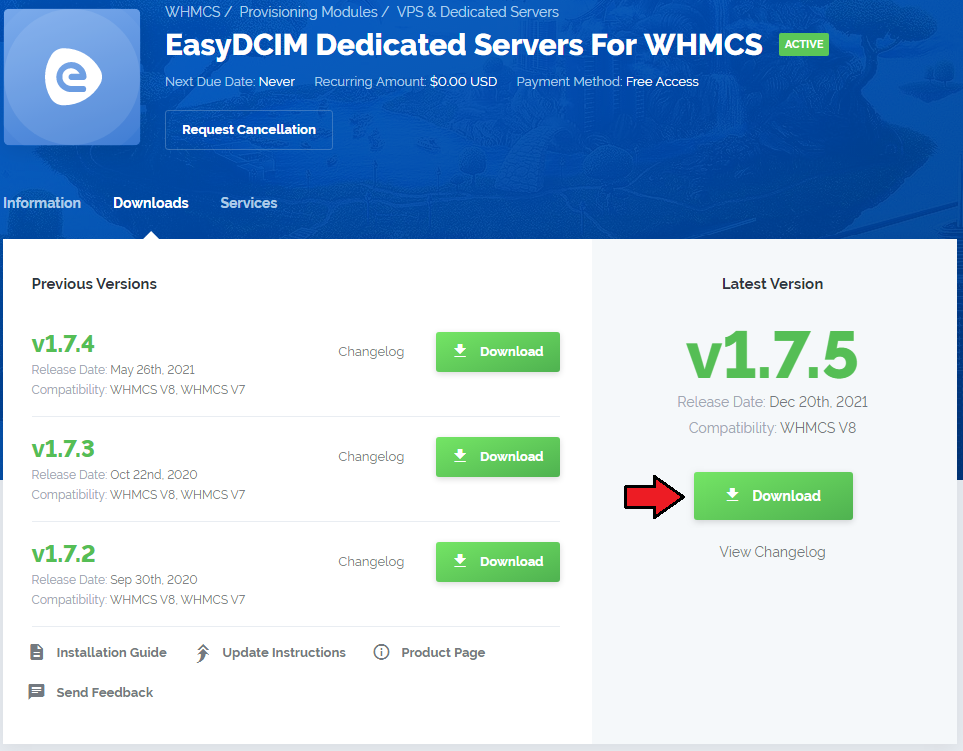
|
| 2. In the downloaded file you will find two packages that support different PHP versions. As presented on the screen below, the first one is dedicated to PHP 7, while the second one is aimed at PHP 5.4 up to PHP 5.6. Note: You can check current PHP version in your WHMCS. To do so, proceed to 'Utilities' → 'System' → 'PHP Info'. |

|
| 3. Extract the downloaded file and choose the one with the right PHP version. Upload and extract the PHP file into the main WHMCS directory. The content of PHP version files should look like this. |
Configuration of Server
| 4. Now, we will show you how to configure a new product. Go to 'Setup' → 'Products/Services' → 'Servers' and press the 'Add New Server' button. |
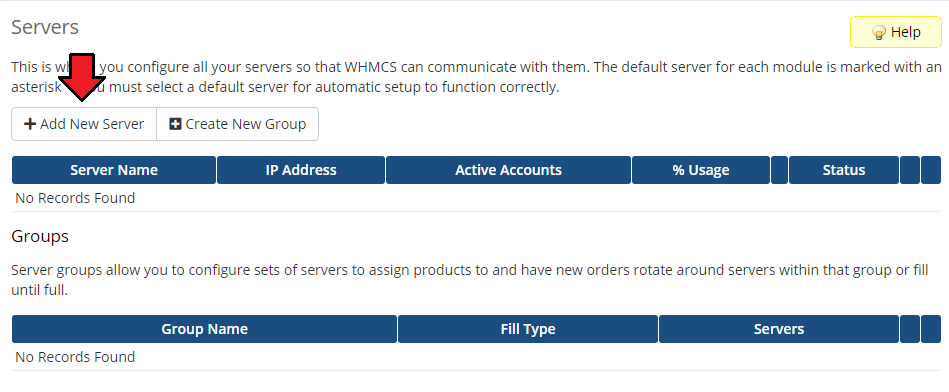
|
| 5. Next, choose 'EasyDCIM' from the 'Type' dropdown menu. Fill in your server name, IP address, username and password, then press 'Save Changes'. |
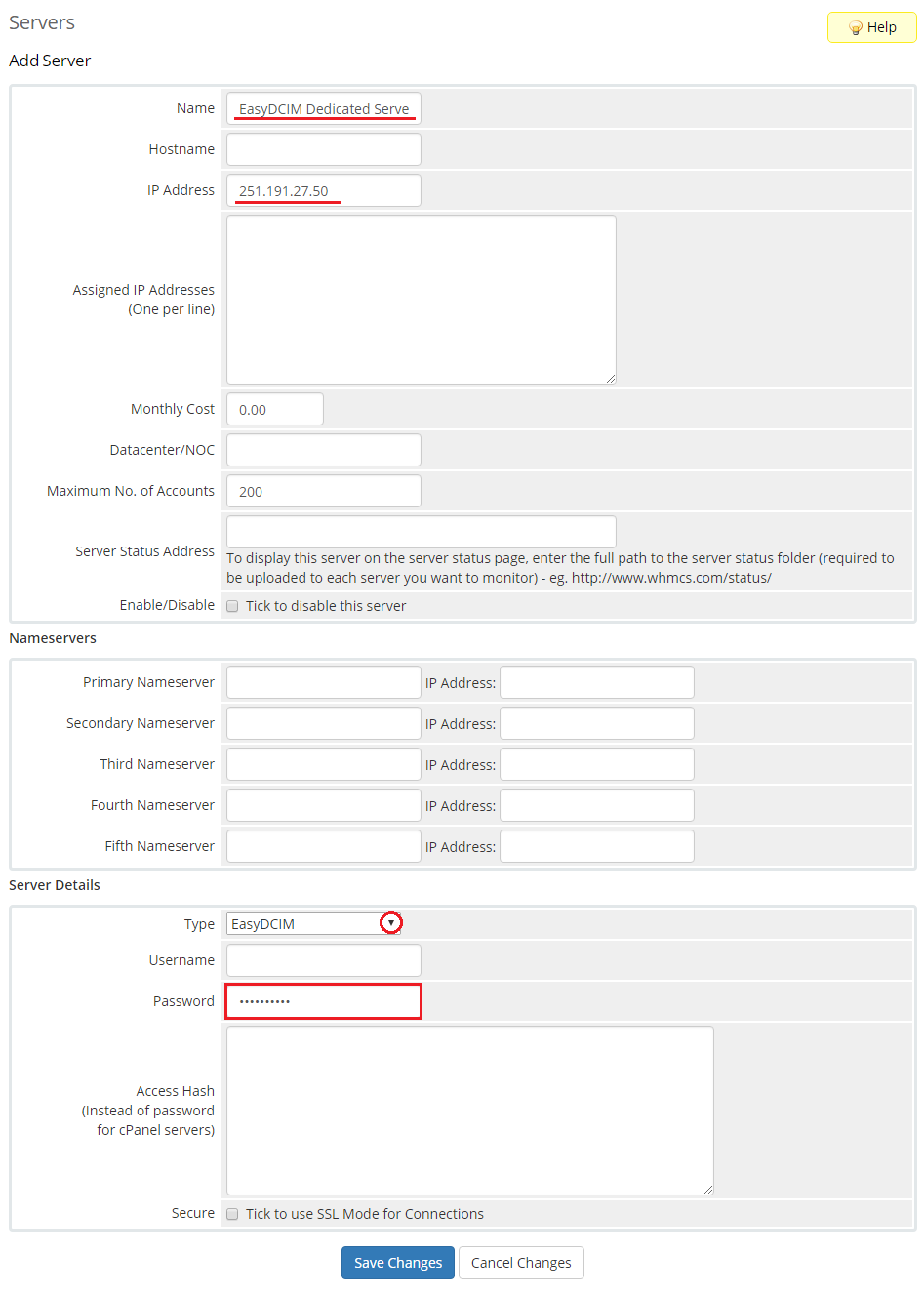
|
| 6. After configuring your server, you can check the connection. In order to check the connection with an EasyDCIM server, edit the server configuration and press 'Test Connection' as shown on the screen below. |
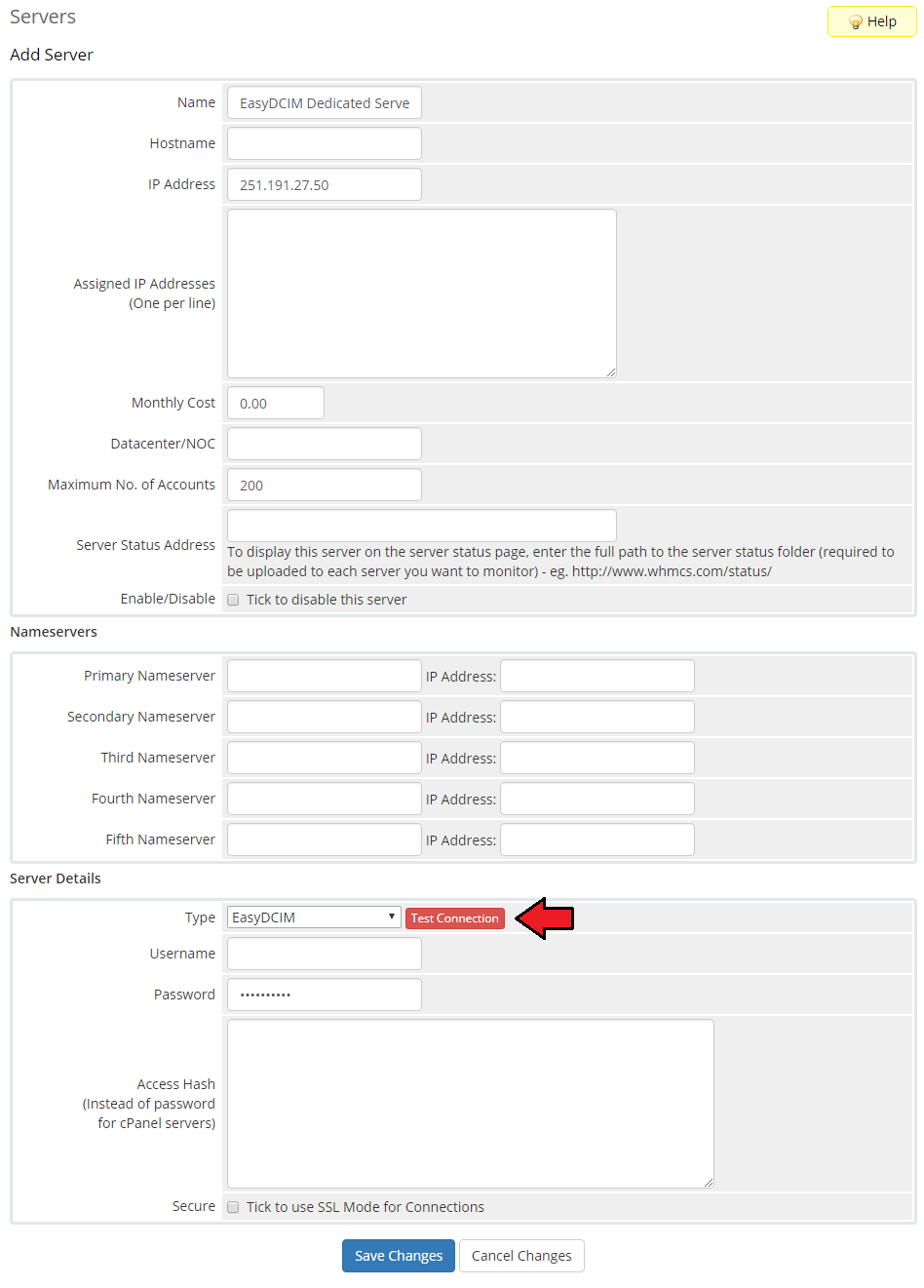
|
| 7. The next step is creating a server group, to do so, click on 'Create Server Group'. |
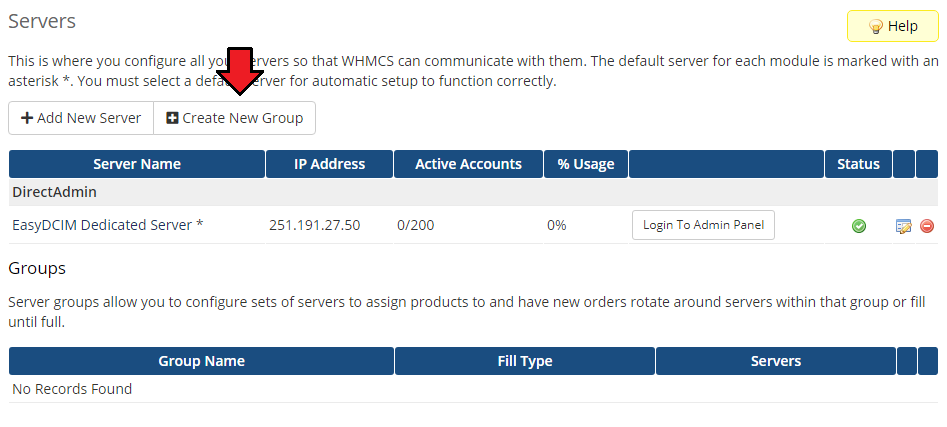
|
| 8. Enter the name, click on your previously created server, press 'Add' and 'Save Changes' afterwards. |
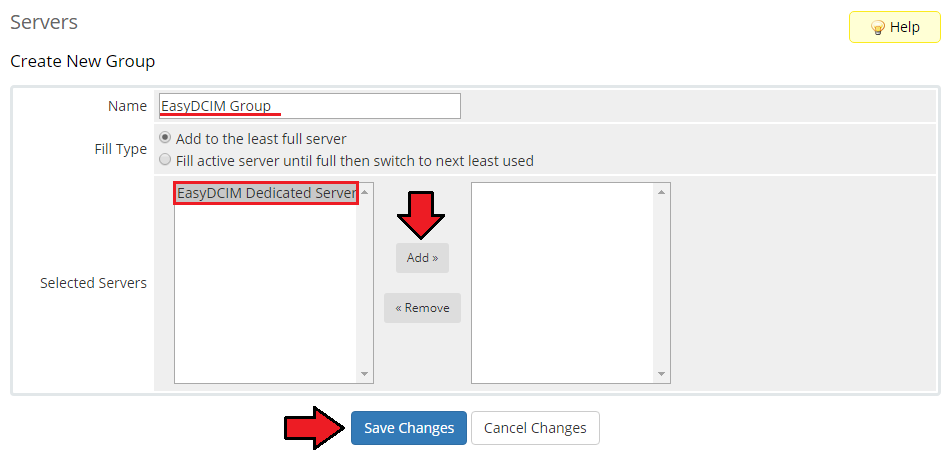
|
Configuration of Product
| 9. In order to create and configure a product, go to 'Setup' → 'Products/Services' → 'Products/Services'. Click on 'Create a New Group'. |

|
| 10. Enter the product group name and press 'Save Changes'. |
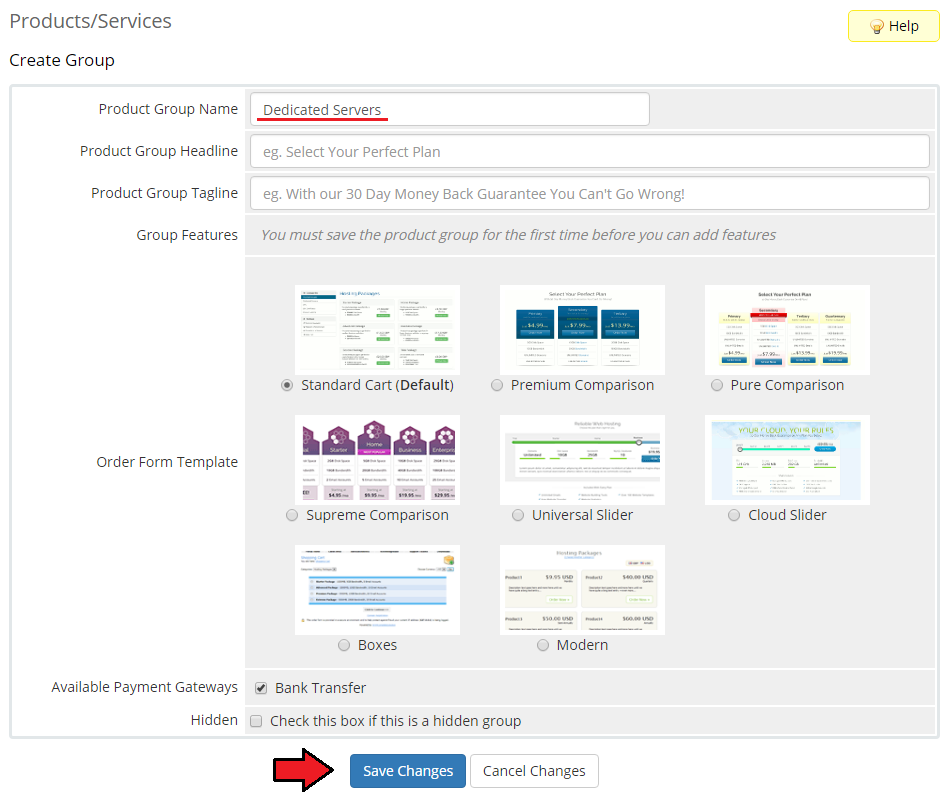
|
| 11. When you have a product group, you can assign your product to it. To create a product, click on 'Create a New Product'. |

|
| 12. Next, choose your product group, enter your product name and then press 'Continue'. |

|
| 13. Now, go to the 'Module Settings' section, choose both 'EasyDCIM' and your previously created server group from dropdown menus. Do not forget to click 'Save Changes'. |
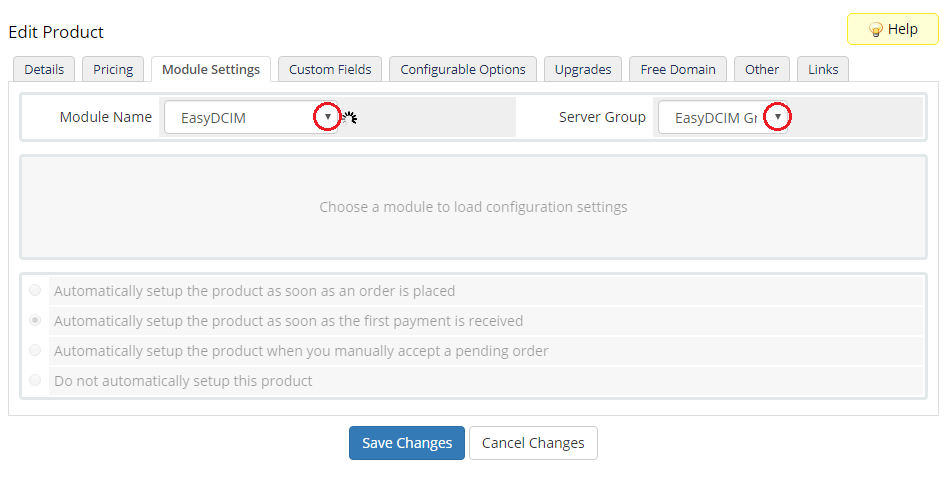
|
| 14. Before configuring the product, set up the EasyDCIM cron job which can be found here. |
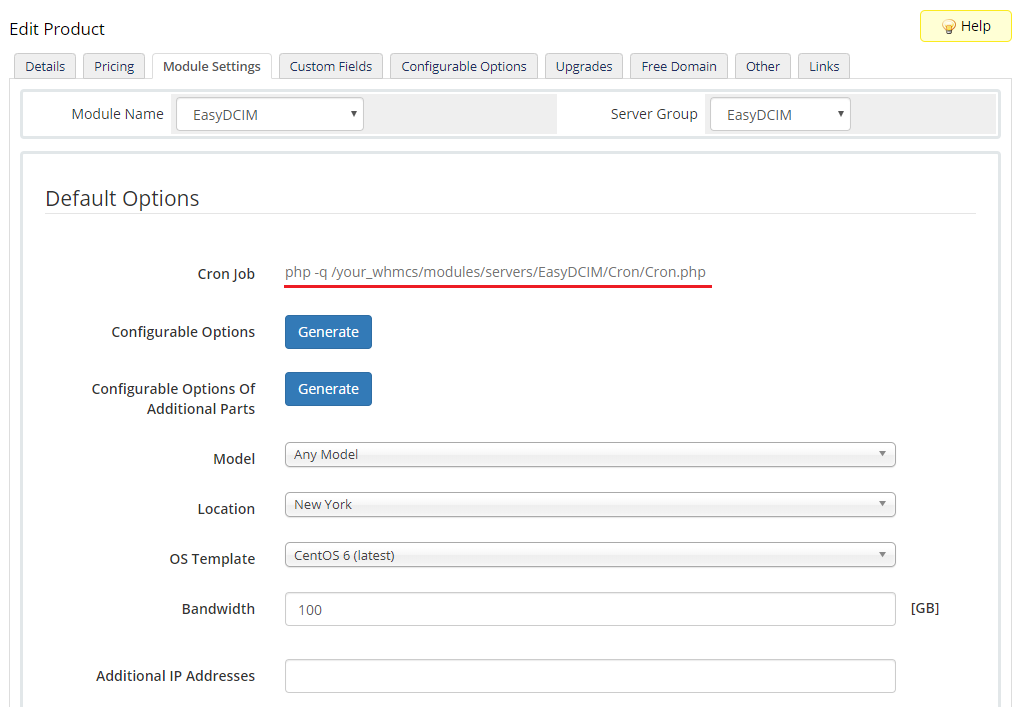
|
| 15. The module configuration is partially non-mandatory. The server will be assigned basing on the defined configuration, matching only the filled out options.
Default Options:
Product Configuration
Items Model
Client Area Features
Service Actions
Service Notification
|

|
| 15. Now, you can optionally generate the default configurable options to allow placing orders tailored to customer needs. We recommend viewing and modifying them to fit your provisioning capabilities. You can find them under 'Setup' → 'Products/Services' → 'Configurable Options'. |
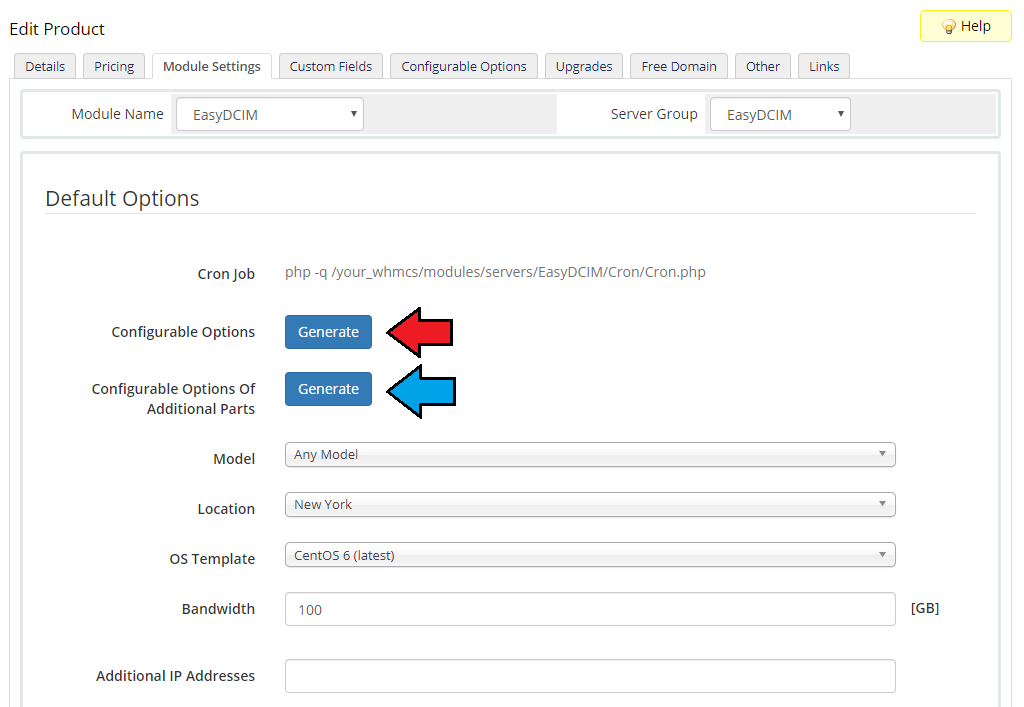
|
| 16. Additionally, you can set up a percentile billing for additional traffic. Go to the 'Other' tab, enable 'Overages Billing' . First, define the standard overages bandwidth billing and then set the following percentile values:
E.g. If 'Soft Limit = 100' and 'Cost = 0.500' and the client exceed the bandwidth to '110 Mbps' , it means that they will be additionally charged with $5 USD amount (10 x 0.500). |
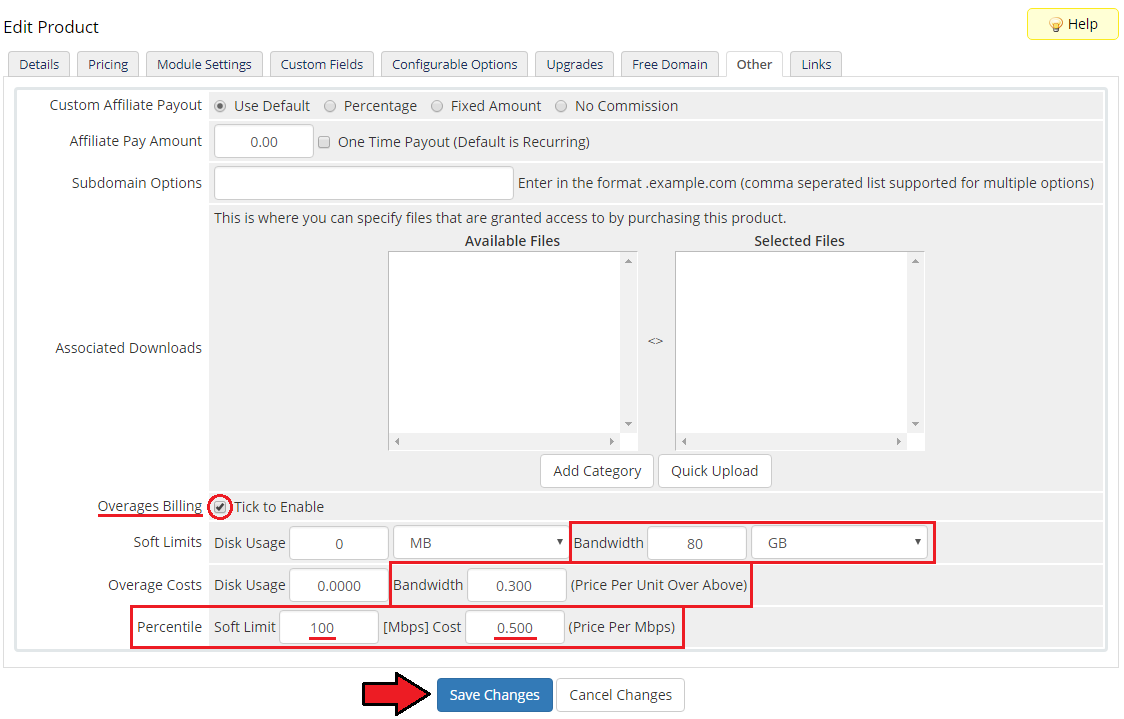
|
Custom Fields
| Once the configuration of the module settings has been completed, the following custom fields will be created automatically. Note: These fields will not be visible to clients by default.
|
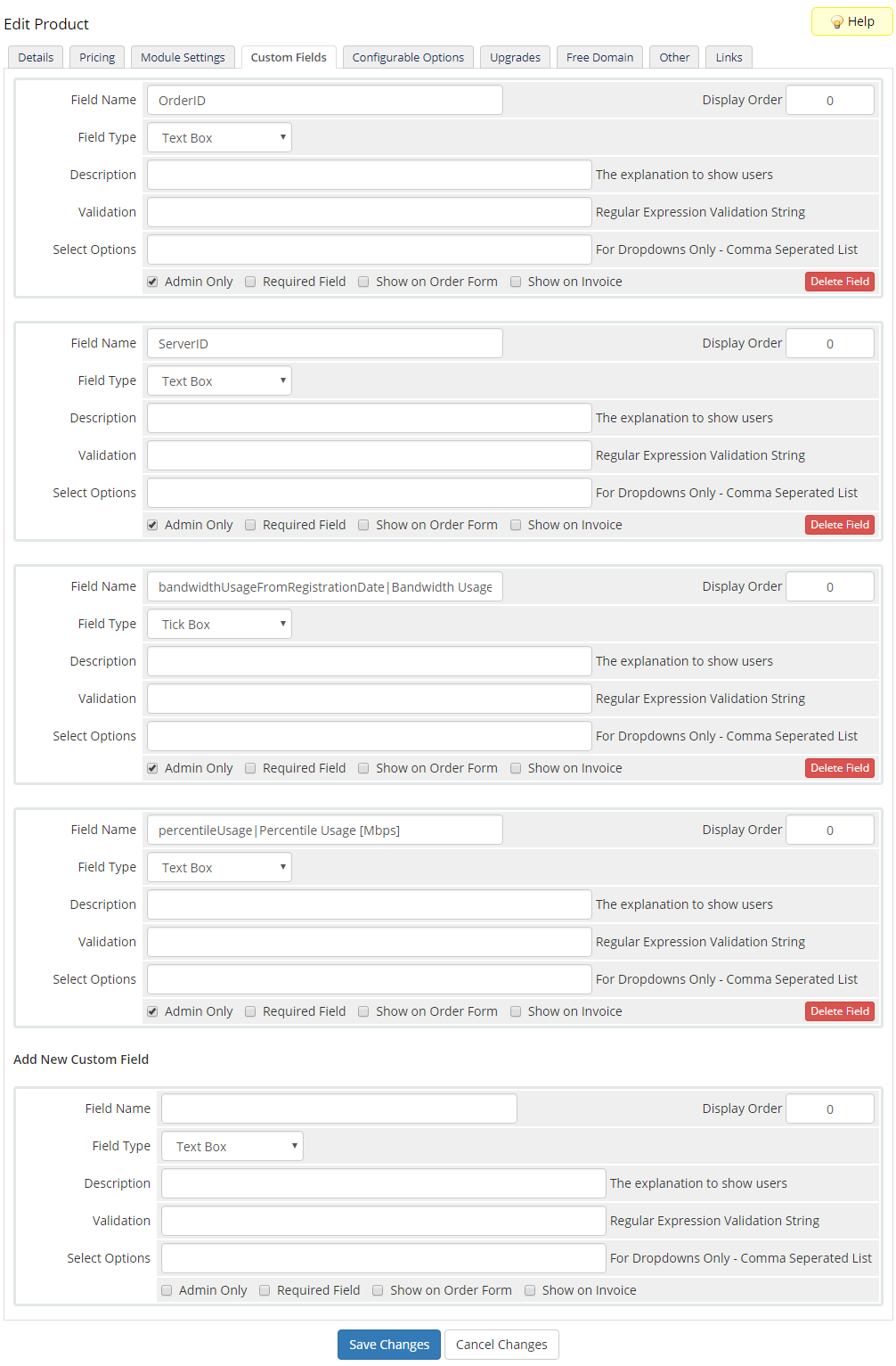
|
Management
| In this section we will show you all the possibilities of EasyDCIM Dedicated Servers For WHMCS. Our module allows you to offer and manage EasyDCIM servers right in your WHMCS system. |
Admin Area
|
As soon as you set up a server for a client, you can request various actions and view server details from WHMCS admin area. |
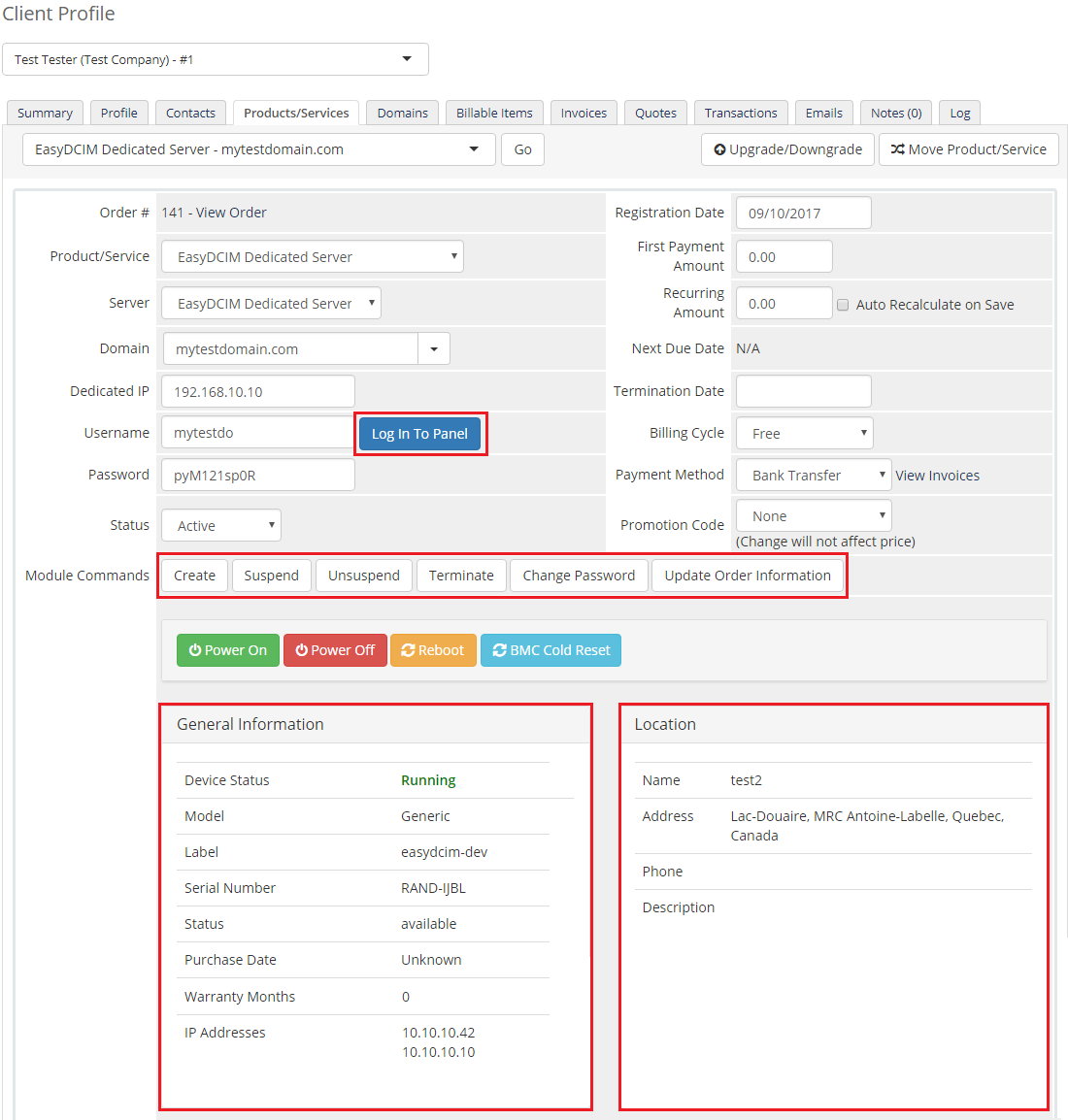
|
| Our module allows you to boot/reboot/shutdown server as well as view its details. |
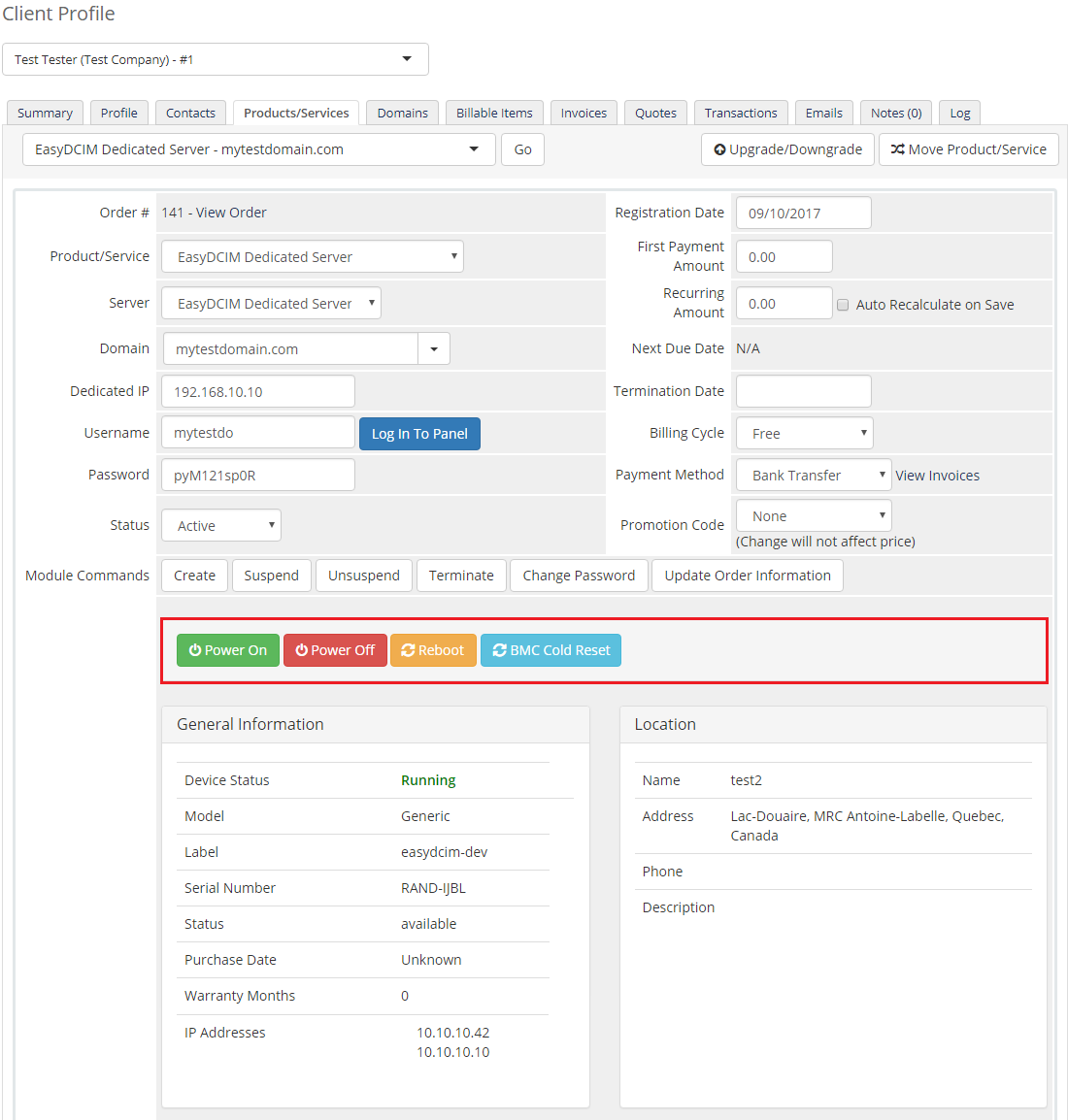
|
| Below the mentioned functions, there are various usage graphs available at your disposal. |
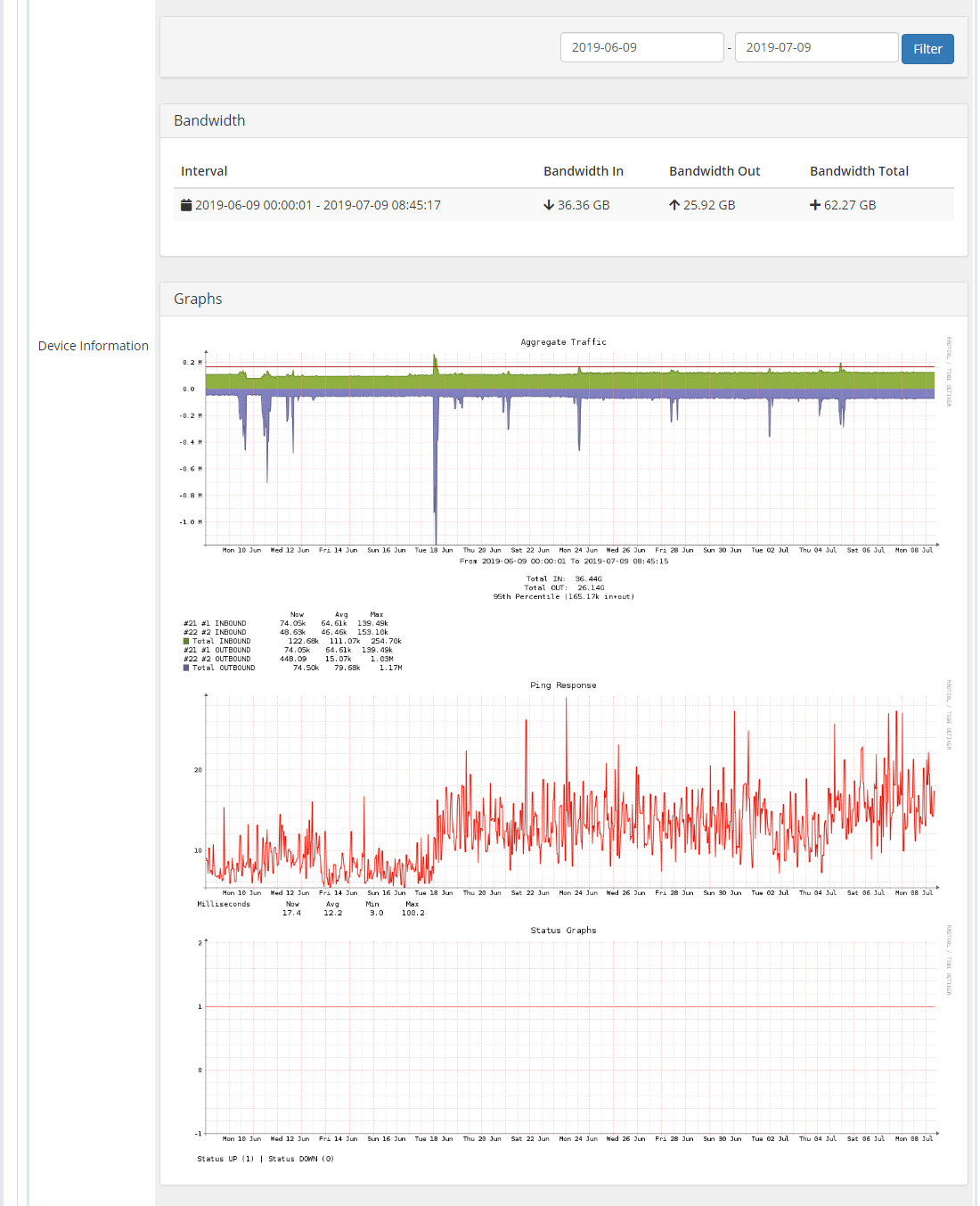
|
Client Area
| In the client area, your customers can view all details concerning their servers, manage their status remotely as well as log in to their EasyDCIM control panel with a single click. |
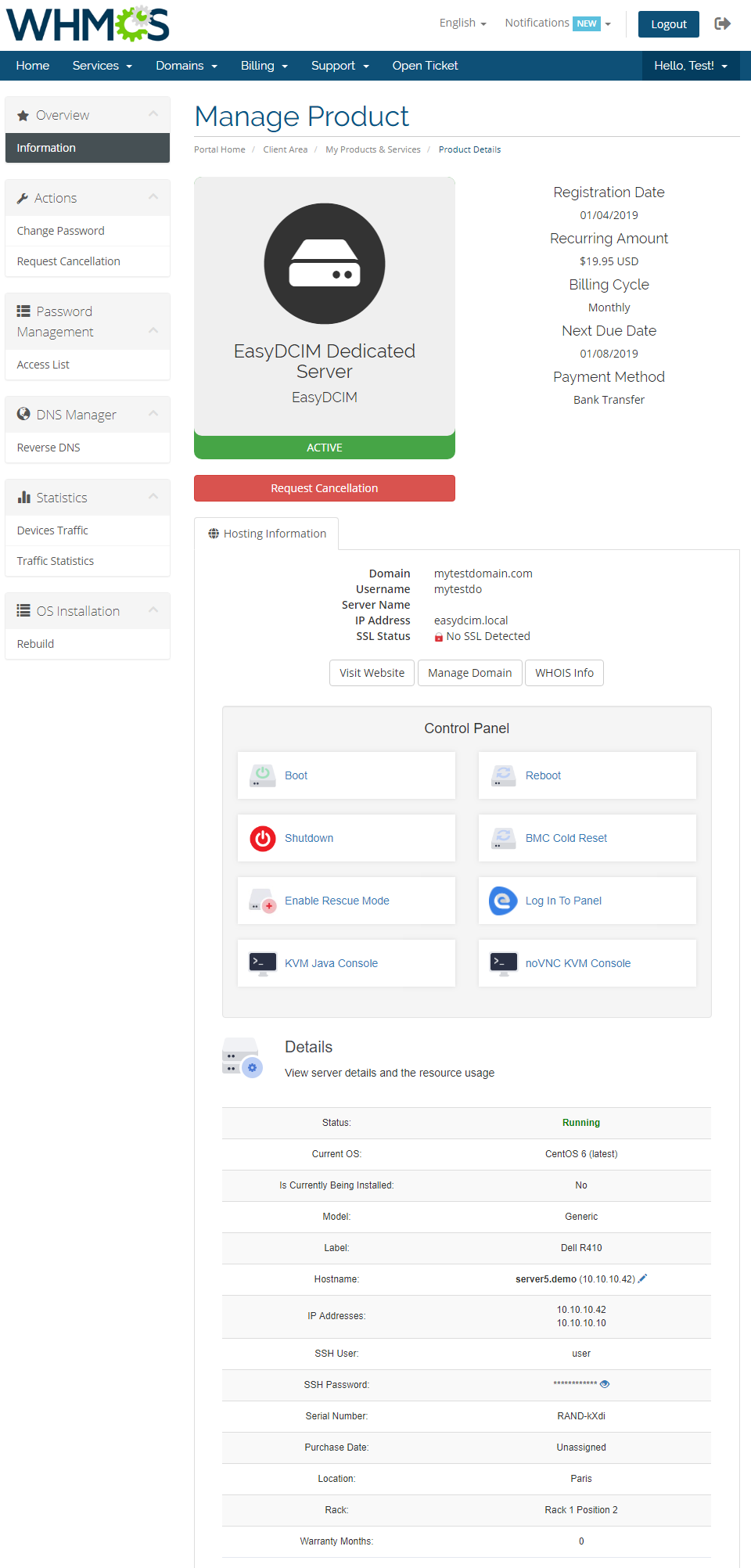
|
| Additionally, you can explore several usage graphs. |
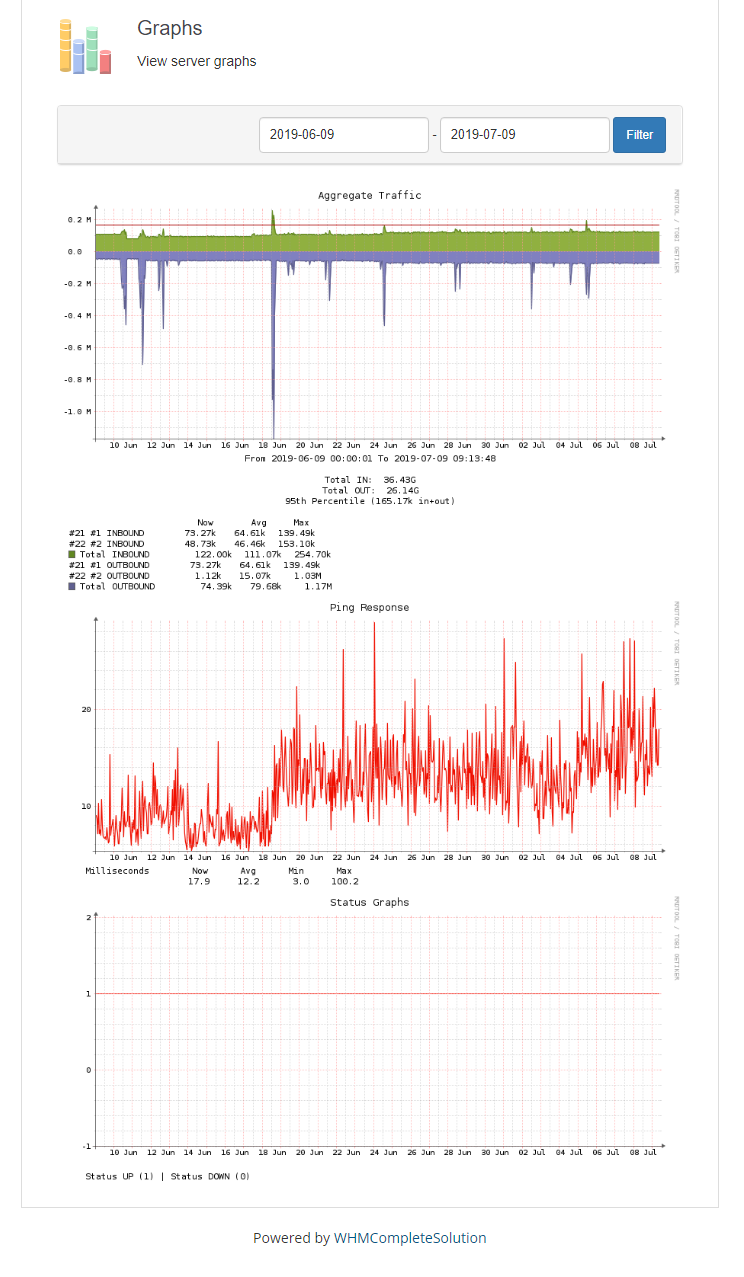
|
| You can also view information about the traffic billing. Note: Available time intervals depend on the date of the product registration. |
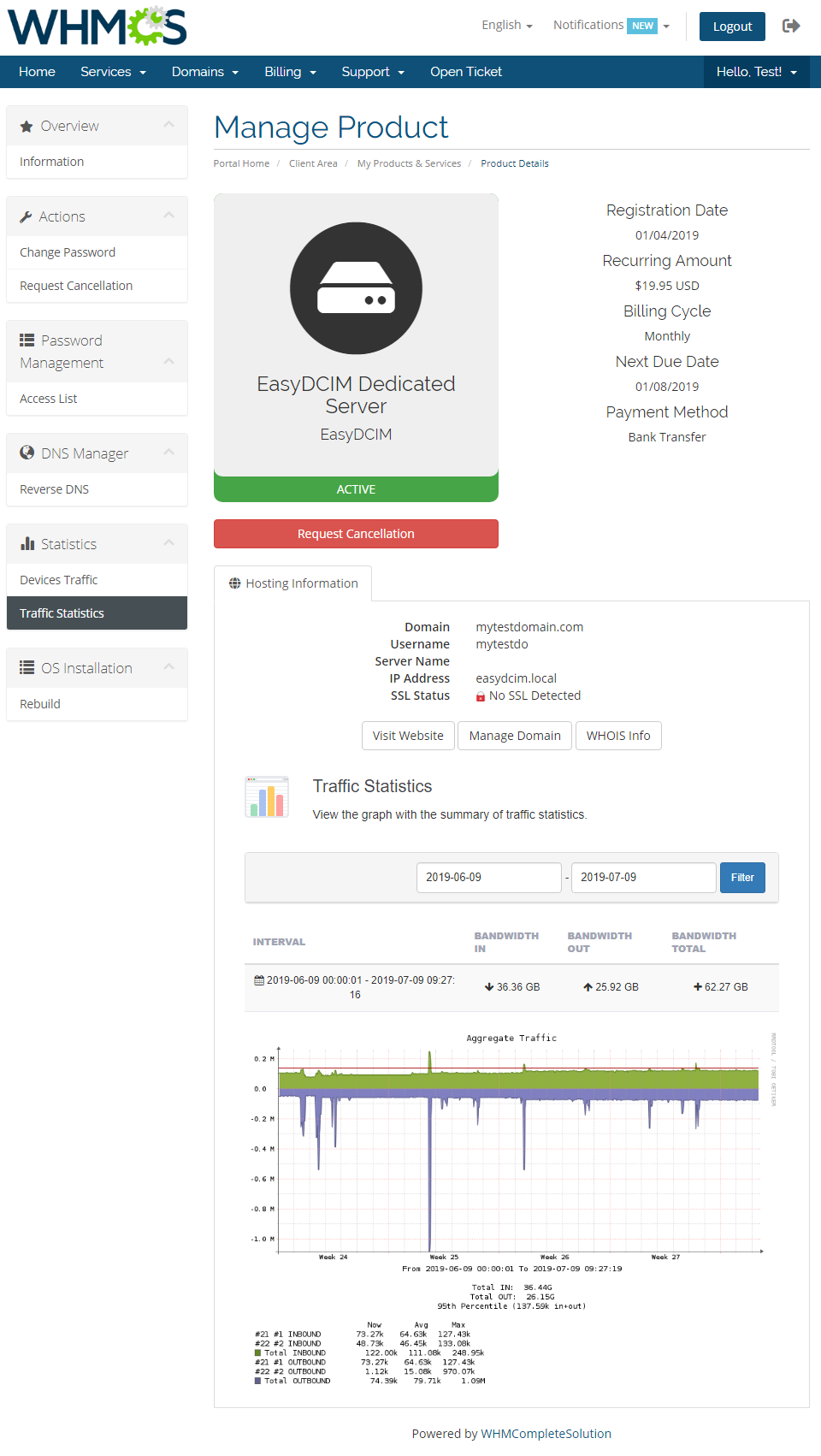
|
| As well as reinstall OS on your server. |
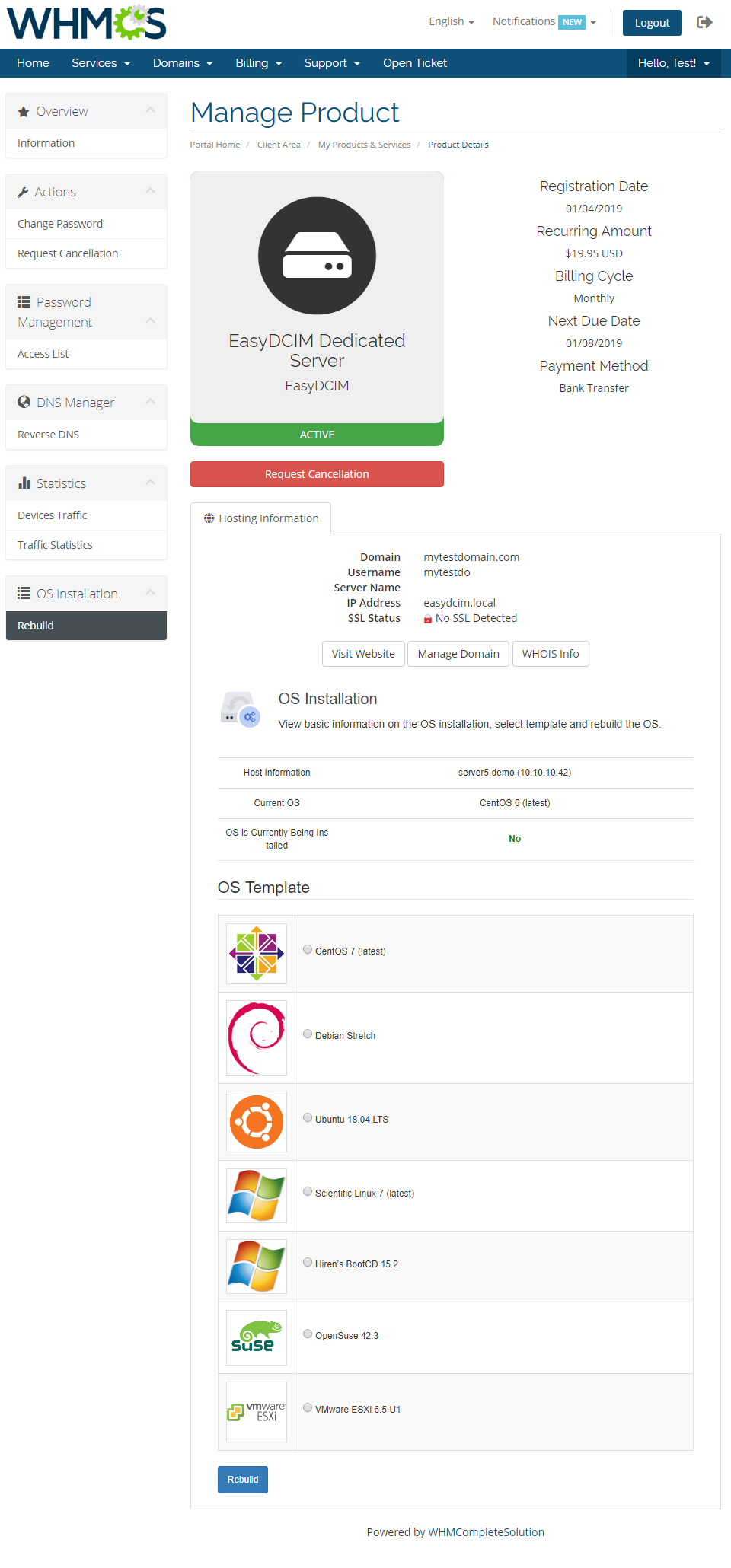
|
| Moreover, it is possible to control your reverse DNS. You can either edit the already existing records or create new ones. |
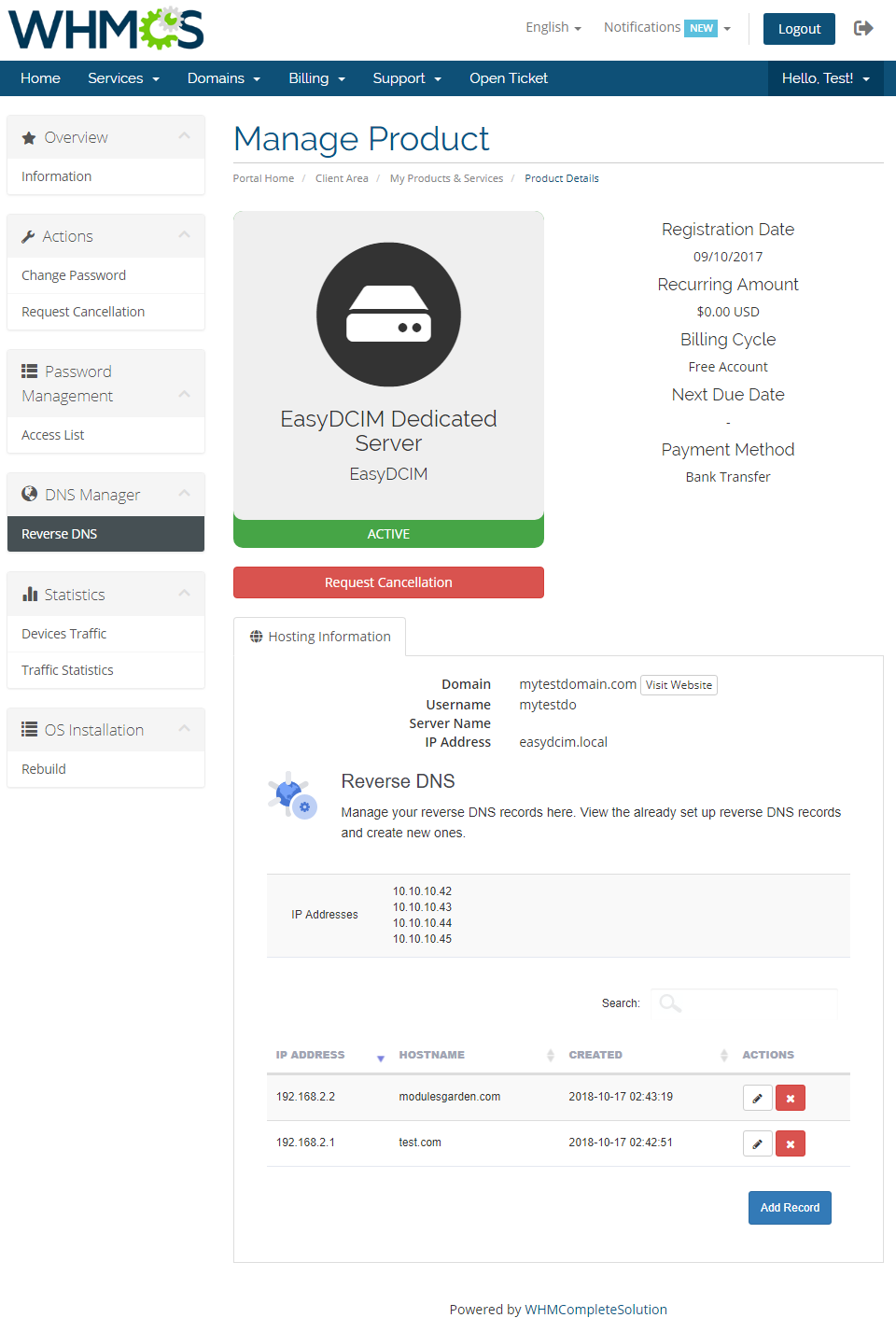
|
| To create a record, just fill in the necessary information. |

|
| Your newly created record will appear on the list. |
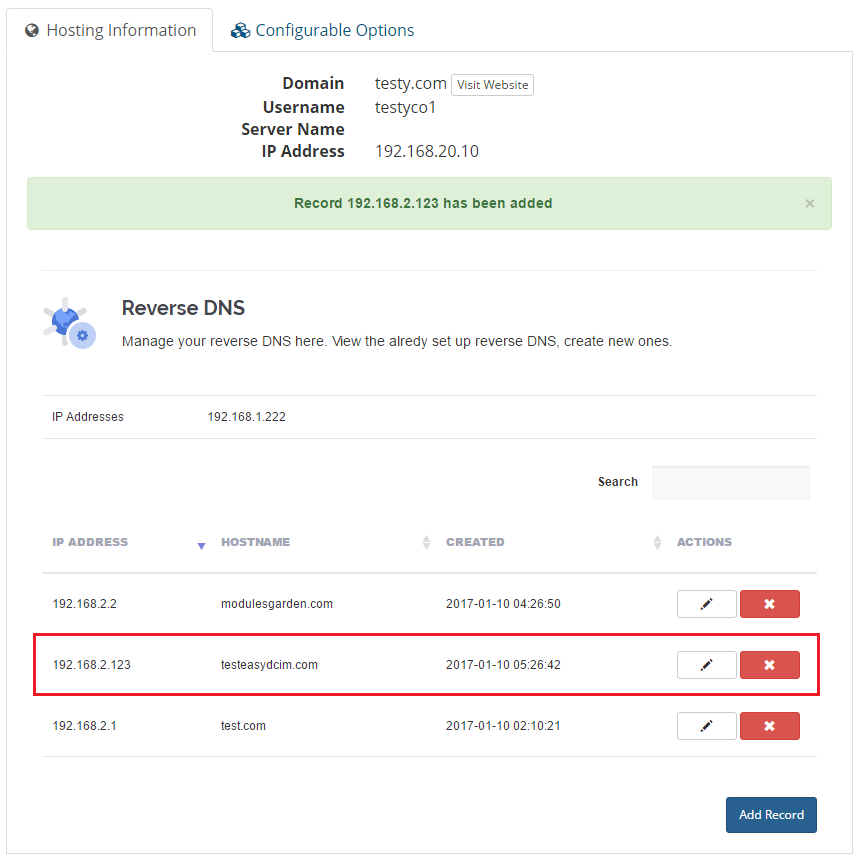
|
| If you are using Dell or SuperMicro servers you can also access the KVM console. |
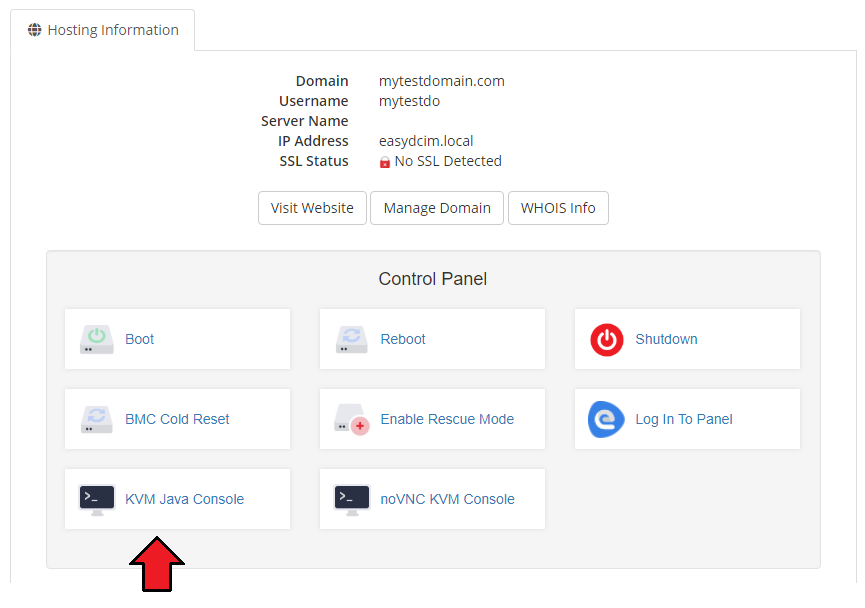
|
| It will launch a Java applet that will automatically connect to your server. Note: Your browser needs to have Java enabled with the correct permissions to make the console functioning. |
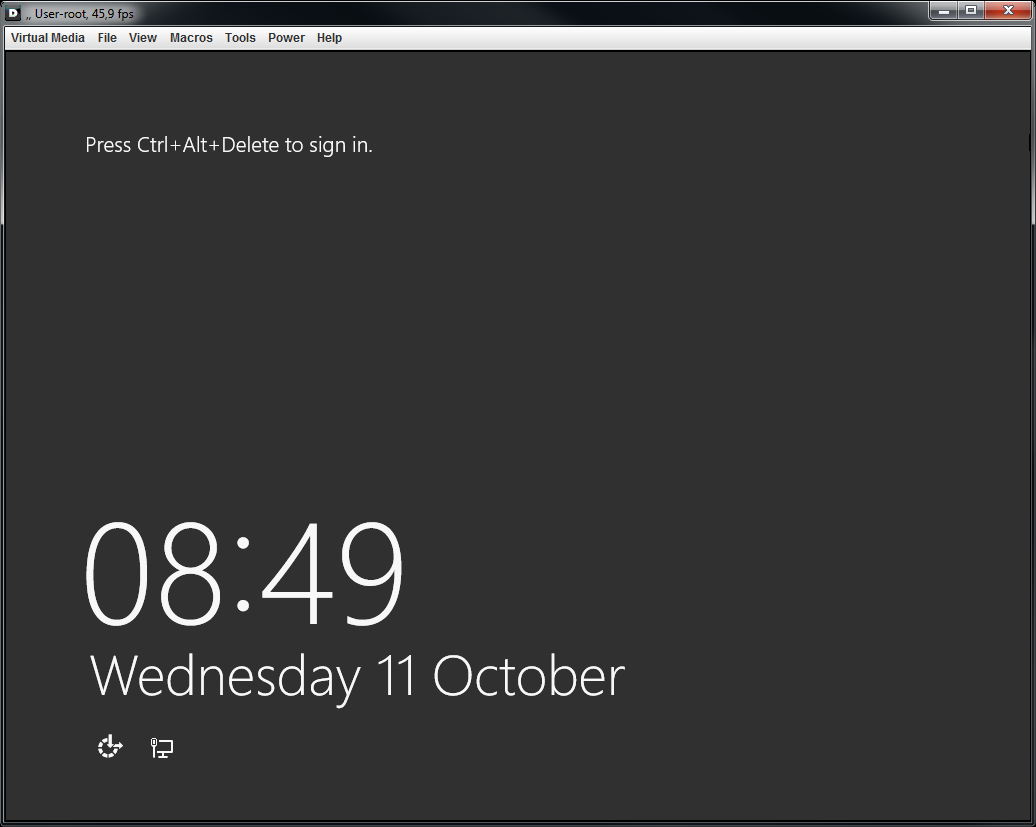
|
Tips
| 1. Note that placing two identical orders may result in assigning server with slightly different parameters.
It stems from the way EasyDCIM server matching works. It matches a server basing on the resources and models mentioned in the order, without considering other resources. |
| 2. As this server supports the templates system, any changes made in the server's templates files will be saved after the upgrade process. |
| 3. Since the 1.3.0 version, the 'monthlyTrafficLimit|Monthly Traffic Limit' configurable option has been changed to 'Bandwidth|Bandwidth' . Remember to change it manually after updating the module. |
Common Problems
| 1. When you have problems with connection, check whether your SELinux or firewall does not block ports. |